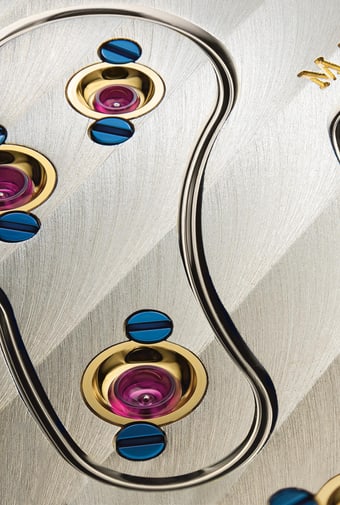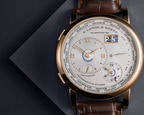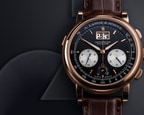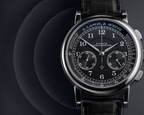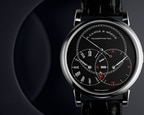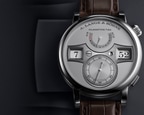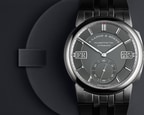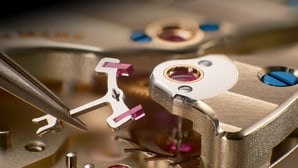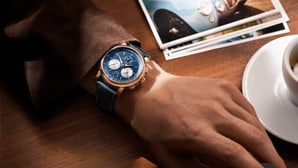Often, a distinctive style is created with only a few special hallmarks. Apart from iconic designs, the A. Lange & Söhne signature stands for mechanical ingenuity. It permeates all models of the 1815 watch family. The watch family, whose name stands for Ferdinand Adolph Lange’s birth year, melds the characteristics of a legacy that began in the early 19th century with contemporary horological know-how, resulting in a fusion of the arts honed to sleek perfection.
Connoisseurs do not even need to see the “A. Lange & Söhne” signature on the dial to realise that they are looking at a Lange watch. A glance at the manufacture calibre through the sapphire-crystal caseback would suffice. Apart from the three-quarter plate, details like the hand-engraved balance cock, the classic screw balance or the gold chatons secured by thermally blued screws are ample evidence. Decorated with solarisation, the winding mechanism wheels are reminiscent of the finissage that once graced high-end pocket watch calibres. The following images afford a closer look at some traditional Lange hallmark parts.
Review: The design of a Lange watch – A. Lange & Söhne
Blued screws
During the final assembly procedure, the first-pass fixture screws are replaced with flawless, thermally blued screws. Their characteristic hue is achieved by slowly heating them to about 300 degrees Celsius.
This process coats the steel with an extremely thin layer of magnetite (Fe3O4); the cornflower blue glimmer is due to interference phenomena. As accents that counterpoint the polished gold chatons and the ruby-red jewels embedded in them, they stand out as eye-catchers on the German silver plates and bridges.
Three-quarter plate
The three-quarter plate is one of the most important traditional elements of A. Lange & Söhne watches. It was introduced by Ferdinand A. Lange in 1864 and since then has established itself as a characteristic feature of watchmaking in Glashütte.
The three-quarter plate accommodates the bearings of the going train. During assembly, it must be accurately positioned over several arbors at the same time, a task which requires a steady hand and a great amount of time and care. But in comparison with conventional configurations based on multiple bridges, this construction adds considerable stability to a movement.
Moreover, a three-quarter plate not only allows a reduction of the axial distance tolerances of the wheels, it also makes movements more resistant to soiling, as evidenced by historic pocket watches
Hand-engraved balance cock and whiplash spring
The engraving on the balance cock is the artisanal fingerprint that makes each Lange watch one of a kind. The small part is embellished with a floral pattern free-hand by a master engraver.
A whiplash spring with a lateral micrometer screw is another typical feature of the movement. It is used to perform precision beat adjustments.
Screw balance
A classic screw balance defines the rate of many Lange watches. Four of the screws are adjustable. The watch ticks slightly faster when they are screwed in and somewhat slower when they are backed out.
This allows the watch to be adjusted in the individual positions until it is optimally calibrated. Minor imbalances can be corrected with the screws as well.
Up/down power-reserve indicator and blued steel hand
The dial also belongs to the suite of classic elements. The form of the power-reserve indicator, with the inscriptions “AUF” (UP) for fully wound and “AB” M164(DOWN) for fully unwound, is an A. Lange & Söhne tradition.
Blued steel hands as well as black Arabic numerals and the very crisp railway-track minute scale assure outstanding legibility. All of these hallmarks are part and parcel of the eminent heritage of historic Lange pocket watches.
Explore further



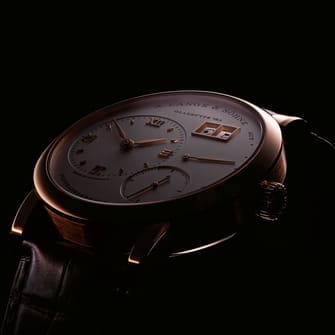
Exclusive insights into the world of fine watchmaking
Experience A. Lange & Söhne’s fascinating heritage, unique stories and exquisite timepieces by subscribing to our newsletter.
How can we be of service?
Whether you are in search of a specific model, have questions out of interest or need a service request for your timepiece – we are delighted to help you. We are at your service by phone, email or in one of our boutiques.

